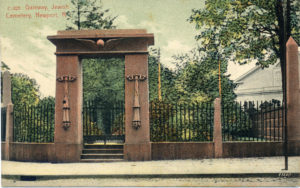
Postcard showing the gates of the Touro Synagogue Cemetery. 2009.3.13, NHS Collections.
The desire to want to memorialize a person or event is natural; monument building, however, can be complicated, often slowed by politics, financial setbacks, and diminishing interest. The American Revolutionary War Battle of Bunker Hill Monument in Massachusetts was no exception. The cornerstone for the monument was laid in 1821, but soon after the project went dormant. Then in 1834 industrialists, literary figures and a better economy stoked renewed interest. Textile merchant Amos Lawrence and the Massachusetts Charitable and Mechanics Association contributed heavily, as did Judah Touro, formerly of Newport, Rhode Island. The Battle of Bunker Hill Monument was finally completed and dedicated in 1843.
Judah Touro was born in Newport on 16 June 1775, the day of the Battle of Bunker Hill. His father Isaac was a founder and Rabbi of Touro Synagogue, built in 1763. Judah eventually moved to New Orleans, LA and became a leading merchant and philanthropist. His many charitable gifts and bequests included giving money to the Bunker Hill Monument, Touro Park and the Old Stone Mill, the restoration of Touro Synagogue, and the construction of the granite gates, and the gates at the nearby Jewish Cemetery. He was interred there shortly after his death in 1854.
Banner: The Battle at Bunker’s Hill / drawn by Henry A. Thomas. United States Boston Massachusetts, ca. 1875. Boston: C. Frank King. Photograph. https://www.loc.gov/item/2006691566/.